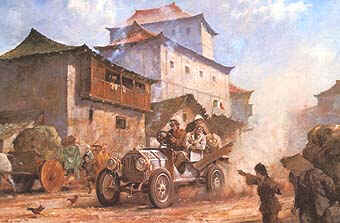1806 The British Museum receives a copy of Protocols
of the Learned Elders of Zion. ^top^
it is a vicious anti-Jewish forgery published
in Russia by Sergyei Nilus in 1805.
Regretfully, Mr. Henry Ford Snr. initiated a campaign of Jew-hate in 1920.
His Book, "THE INTERNATIONAL JEW" WAS BASED MAINLY ON "THE
PROTOCOLS'. Howevert Mr. Ford completely retracted his views expressed
in his book:
"To my great regret I learn that in the Dearborn Independent and
in reprint pamphlets entitled, 'THE INTERNATIONAL JEW',
there have appeared articles which induce the Jews to regard me as their
enemy, promoting anti-Semitism.
"As a result of this survey I am deeply mortified that this journal,
which is intended to be constructive and not destructive, has been made
the medium for resurrecting exploded fictions, for giving currency to
the so-called Protocols of the Wise Men of Zion, which have been
demonstrated, as I learn, to be gross forgeries, and for contending that
the Jews have been engaged in a conspiracy to control the capital and
the industries of the world, besides laying at their door many offences
against decency, public order and good morals...I deem it to be my duty
as an honourable man to make amends for the wrong done to the Jews as
fellow men and brothers, by asking their forgiveness for the harm which
I have unintentionally committed, by retracting, as far as lies within
my power the offensive charges laid at their door by these publications,
and by giving them the unqualified assurance that henceforth they may
look to me for friendship and good will...
"Had I appreciated even the general nature to say nothing of the
details of these utterances, I would have forbidden their circulation
without a moment's hesitation...This statement is made on my own initiative
and wholly in the interest of right and justice, and is in accordance
with what I regard as my solemn duty as a man and as a citizen."
What are the Protocols?
As many of our readers may not be familiar with this infamous forgery
the following is a brief summary of its evil ingredients. The "Protocols"
are set forth as the minutes of twenty-four secret sessions of "the innermost
circle of the rulers of Zion". These fictitious minutes are thus laid
down as twenty-four "Protocols" or master plan to enslave the world by
the most dastardly and unscrupulous methods imaginable. here are a few
examples:
- "Our right lies in force. The word "right" is an abstract thought
and proved by nothing. The word means no more than: Give me what I want
in order that thereby I may have a proof that I am stronger than you."
- Protocol 1. Article 12.
- "The administrators, whom we shall choose from among the public,
with strict regard to their capacities for servile obedience, will not
be persons trained in the arts of government, and will therefore easily
become pawns in our game in the hands of men of learning and genius
who will be their advisors, specially bred and reared from early childhood
to rule the affairs of the whole world."- Protocol 2. Article 2.
- "In order to put public opinion into our hands we must bring it
into a state of bewilderment by giving expression from all sides to
so many contradictory opinions and for such length of time as will suffice
to make the gym (Gentiles) lose their heads in the labyrinth and come
to see that the best thing is to have no opinion of any kind in matters
political, which is not given to the public to understand, because they
are understood only by him who guides the public. This is the first
secret."- Protocol 5. Article 10.
- "The Press, which with a few exceptions that may be disregarded,
is already entirely in our hands."- Protocol 7. Article 5.
How Did the Protocols Originate?
In 1901 a Russian official in the Chancery of the Synod of Moscow named
Serge A. Niles published a strange work entitled, "The Great in the Little
and the AntiChrist as a Proximate Political Possibility". Nilus expressed
the view that only the Holy Russian Empire could save the world from the
rule of Antichrist. The idea behind the book was to bolster the absolute
authority of the Czarist regime. In 1905 a second edition of the book
appeared with one significant addition - the Protocols! Thus was born
one of the most infamous documents ever published. And only Nilus himself
ever claimed to have seen the original.
The "Protocols" Exposed as an Infamous Forgery
In August 1921 Mr. Phillip Graves, correspondent of the London "Times"
in Constantinople came into the possession of a small book in a tattered
condition. Such an insignificant incident may well have passed unnoticed
and been swallowed into oblivion had not Mr. Graves recognized a sentence
as being identical with one of the "Protocols". Yet, THIS BOOK HAD THE
NAME "JOLI" AS THE AUTHOR!
Mr. Graves compared the book written by Monsieur Joli with a copy of
the "Protocols" and in it he found repeated word for word, paragraph for
paragraph and page for page the text of the earlier book written by Joli.
The only alteration was that instead of the word "Zion" Joli had written
"France", and instead of "We the Jews" the original book had "The Emperor"!
The book written by Joli was a satire directed against Napoleon III
and was entitled "Dialogue in Hell between Machiavelli and Montesquieu".
IT HAD NOTHING WHATEVER TO DO WITH THE JEWS!
In three consecutive issues dated 16th, 17th and 18th August, 1921 the
London "Times" printed long extracts from the "Protocols" side by side
with Joli's "Dialogue in Hell". Thus was the infamous forgery exposed
as ONE OF THE MOST INSOLENT FORGERIES OF ALL TIME.
Count Heinrich Coudenhove-Kalergi in his book "ANTI-SEMITISM THROUGHOUT
THE AGES" (English translation, Hutchinson, 1935) writes: "This plagiarism
is an anti-Semitic forgery from the beginning to the end without any connection
whatever with Jewish personalities, groups, organizations or conferences.
The publication is in no wise, whether directly or indirectly, a product
of the Jewish spirit, or Jewish tradition, or of Jewish sentiments and
opinions.
"In the entire fraud committed against humanity which the "Protocols"
represents, the Jews are merely innocent objects, while the anti-Semites
were the guilty agents. Thousands of Jews have been massacred, maltreated,
plundered and imprisoned in the Ukraine and in Germany on account of this
forgery. At the same time many millions of non-Jews have been deceived
by the "Protocols", they have been induced to commit deeds and to utter
words which they would most deeply regret were the facts of the forgery
known to them. No book and no event in the history of modern anti-Semitism
has played such an important part as this plagiarism; it constitutes
the piece de resistance, the choice morsel of after-war anti-Semitism.
"It is, therefore, they duty of all decent men in the world, be they
non-Jews or Jews, Anti-Semites or Philo-Semites, to work with all their
might and see to it that this shameless lie, forgery and calumny disappears
from the world.
"It ought to be made clear to all those who know the "Protocols"
that the publication is a plagiarism of fatal world importance. The work
of enlightenment is not only a duty to the calumniated Jews, but also
to truth, for it is no exaggeration to say that the so called "Protocols
of the Elders of Zion" are both one of the most insolent forgeries of
all time and one of the meanest calumnies which has existed in human history."
Hitler knew only too well how to manipulate the masses with lies of great
magnitude and he exploited the "Protocols" to the fullest extent. Four
years after the publication of the warning contained in Count Kalergi's
book the harvest of hatred against the Jews began in Europe, and the flames
of the holocaust were not extinguished until six million innocent Jewish
victims had perished.
The Law Steps In
Dr. A. Zander, editor of a Swiss Nazi organ, published a series of articles
on the acceptability of the "Protocols". But Swiss law offered redress
and community leaders in that country determined to expose the fraudulent
basis of the iniquitous document before a well-respected court of justice.
Trial began in Berne on October 29, 1934, the plaintiffs being Dr. J.
Dreyfus-Brodsky, Dr. Marcus Cohen, and Dr. Marcus Ehrenpreis.
On May 19, 1935, the Cantonal Court of Berne, after full investigation
declared the "Protocols" to be forgeries, plagiarisms, and obscene literature
and gave judgment in favour of the Cantonal Bernese Act. The Nazi, Dr.
Zander, was fined.
At Grahamstown, South Africa, in August, 1934, the Court imposed fines
totalling 1.775 ($4,500) on three men for concocting a modern version
of the "Protocols". |
 ^top^
^top^ 1999
Karla Selley, 5, by asphyxia when coming out of general anesthesia
in botched tooth extraction.
1999
Karla Selley, 5, by asphyxia when coming out of general anesthesia
in botched tooth extraction.  1847
Adam Wolfgang Töpffer, Geneva painter, caricaturist, and engraver,
born on 20 May 1766. —
1847
Adam Wolfgang Töpffer, Geneva painter, caricaturist, and engraver,
born on 20 May 1766. —